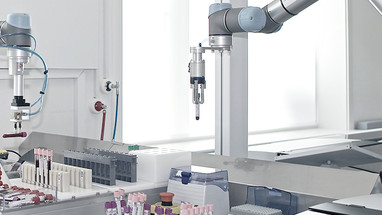Mar 15th 2017
Packaging Line Automation
With a goal of reducing costs, consistently producing high quality product and increasing profits, selecting the right level of automation for a packaging line can be tricky: it’s not as simple as throwing together a bunch of robots and automation.
Two automation options may be available depending on the application: full automation and partial automation. Fully automated systems operate with virtually no human interaction whereas partial systems are still somewhat dependent on worker involvement.
Partially automated lines offer increased flexibility in operations and are ideally suited to using collaborative robots, such as Universal Robots, that can easily work alongside employees. The partial, collaborative system empowers employees’ critical thinking skills to solve real-time issues on the floor. While this is an affordable and user-friendly option, employees require training and development, which makes employee-retention imperative.
Fully automated systems can virtually eliminate employees present on a production line and are well suited industries such as pharmaceuticals. FDANews reports that errors by employees account for almost 80% of nonconformities in the pharmaceutical industry. For this application, consistent product is mandatory and a fully automated line can ensure that these companies comply with quality and safety regulations.
In addition to achieving consistency, fully automated packaging lines nearly eliminate the opportunity for workplace injuries. The ability to control a fully automated line remotely as well as general improvements in automation design protect both company and employee.
Automation Distribution representatives walked the floor of the recent Philadelphia Pack Expo where the latest automation technologies were showcased. “This was the first year I remember they had collaborative robots,” said Sam Hostvedt, President of Automation Distribution. Company COO Phil Marchese noted that predictive intelligence stood out the most to him combined with the trend of providing “integrated systems rather than component functions.”
Marchese points out that shows like the Pack Expo are of great benefit to clients. “Clients can see how to drive production and cost efficiencies as well as learn about new technology and applications that they may utilize in the future.”
Advancements in automation call for continuous education. Shows like the Pack Expo are great resources for those looking to improve their automation systems, learn about new packaging and automation technologies, and expand their knowledge base to find the best possible packaging automation solution.

